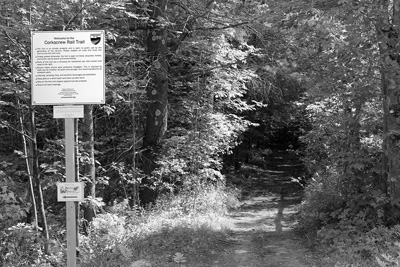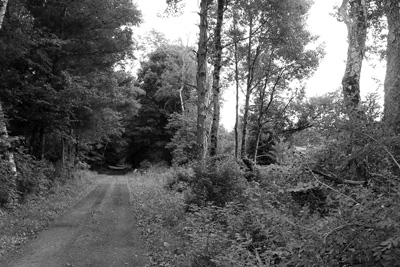News & Issues August 2015
Reviving the Corkscrew route
Newly opened rail trail feeds dreams of a wider hiking network
 By JOHN TOWNES
By JOHN TOWNES
Contributing writer
STEPHENTOWN, N.Y.
A sign welcomes visitors the newly opened Corkscrew Rail Trail in Stephentown. The trail extends along 2.5 miles of a long-defunct railroad route that once stretched nearly 60 miles from Chatham to Bennington, Vt. John Townes photo
This summer, walkers and bikers began using a small portion of an eastern New York transportation corridor that had been dormant for more than 60 years.
The first section of the new Corkscrew Rail Trail opened in June, allowing recreational use of a 2.5-mile path along a former railroad line that once extended nearly 60 miles from Chatham to Bennington, Vt. The route, a branch of the Rutland Railroad that was dismantled in 1953, was known as the “corkscrew line” because of its many tight curves as it wound its way along the New York-New England border.
Although the newly opened trail is a modest unpaved path, creating it required some serious effort. The rail line was abandoned so long ago that the right of way has fallen into the hands of many different landowners.
Organizers say they hope the opening of the new trail section will be the first tangible step in an effort to link other sections of the former rail bed to form a longer trail through Stephentown and New Lebanon – and eventually, perhaps, to other towns along the old railroad route.
The project is one of several independent local efforts around the region to establish recreational trails along abandoned railroad grades and other corridors. Some of these also have the potential to connect eventually into a regional network of trails that would allow users to travel longer distances.
To the south, the Harlem Valley Rail Trail roughly parallels Route 22 for much of the roughly 25 miles from Wassaic to Hillsdale, and organizers hope one day to extend it northwest to Chatham, the southern end of the old Corkscrew line. Somewhat to the north of the Corkscrew line, the Delaware & Hudson Rail Trail is open in segments totaling nearly 25 miles from the state line near Salem, N.Y., to Castleton, Vt.
Local focus
In Stephentown, the newly opened trail is the result of work done by the Corkscrew Rail Trail Association, a grassroots coalition whose members stress that their focus is on assembling a trail within the towns of New Lebanon and Stephentown. Just within these two towns, the process has been long and complex -- with more than a few challenges.
“We’re in the very early stages of this,” said Joe Ogilvie, the association’s president. “It’s going to require a lot of effort and time. But we’re in this for the long haul, because we believe the results will be a great asset for the community.”
The route that is the focus of the group’s efforts was originally assembled in the 19th century as the Lebanon Springs Railroad. It became a larger regional railroad system and eventually was acquired by the Vermont-based Rutland Railroad in 1901.
The Corkscrew line began in Bennington and wound its way into New York and south through Petersburgh, Berlin, Cherry Plain, Stephentown and New Lebanon. It then headed southwest to Chatham, where it tied into a major east-west line from Boston to Albany as well as a route south to New York City.
Although the line carried passengers and other freight, it was known mainly as a “milk run” because it transported milk from Vermont’s dairy farms southward toward metropolitan New York.
Today the former railroad right of way goes through a mix of open land and woods as well as areas of commercial and residential development. It roughly parallels Route 22 from Petersburgh to New Lebanon, and then turns to the west, running north of Route 20 to the hamlet of Brainard, just west of the Lebanon Valley Speedway.
Seeking willing landowners
The idea of reviving the route as a recreational trail has been discussed for at least a decade. In New Lebanon and Stephentown, supporters banded together to form the Corkscrew Rail Trail Association about two years ago.
The group’s goal is to obtain permission from the owners of individual sections of the former track bed to allow easements for public access the trail. The group is working to link the segments where landowners are amenable to the idea – and to look for alternate connecting routes in areas where it isn’t possible to follow the original rail route.
“This is totally dependent on the voluntary participation of property owners,” Ogilvie explained. “Any extension of the trail will require their support.”
 The newly opened trail starts at Knapps Road, west of Route 22 in Stephentown. From there it goes south, crossing Wyomanock Road and continuing to just above New Lebanon. The route is in a rural section of Stephentown and crosses through some open fields and large residential properties, with woodland and wetlands on either side.
The newly opened trail starts at Knapps Road, west of Route 22 in Stephentown. From there it goes south, crossing Wyomanock Road and continuing to just above New Lebanon. The route is in a rural section of Stephentown and crosses through some open fields and large residential properties, with woodland and wetlands on either side.
Although some rail trails are paved, the Corkscrew Rail Trail is more primitive. It is essentially a path, although one portion of it is a dirt road.
“We’re trying to keep the trail simple,” Ogilvie said. “We don’t want to do anything fancy, and we’re not trying to make it a paved trail.”
There are practical reasons for that. The trail association is a truly grassroots effort and is not affiliated with any public government project. Supporters of the trail have been paying costs out of their own pockets or with donations. As a result, they are not in a position to purchase land or undertake expensive design, engineering and construction projects.
Ogilvie said the group was able to open this initial section of the trail because it uses an existing pathway that landowners had agreed to make available.
“Most of the expense has been paying to have the signs made,” he said.
Mixed responses
One of the landowners who gave permission for public use of the initial trail segment is Mona Berg, who operates the Berkshire Mountain House, a local bed-and-breakfast inn.
“One of the things I admired when I was in England was the fact that in many places there are public trails behind private properties,” Berg said. “So when I heard about this trail, I thought it was a great idea.”
In some cases, sections of the proposed trail have been long used by the public on an informal basis. But other sections have not been accessible, and allowing public use would be a significant change.
To build support for the idea, proponents have held public meetings and have sought out individual property owners and local officials.
“We also have been working to generate support from the larger community,” Ogilvie said. “We are pointing out how the trail will be good for the towns on many levels. It’s a recreational and health resource for local residents. It can also be an attraction for visitors and stimulate business activity.”
Ogilvie said the response among landowners has been varied.
“Some people have been supportive right away,” he said. “Others are receptive, but they have concerns and are not ready to allow access to their property yet. And there are some who have no interest in participating.”
Among the concerns of landowners are privacy and the potential for misuse or misbehavior by users of the trail.
Another concern is liability. In New York, however, state law protects landowners from liability for accidents or other problems that may arise from public use of their land – as long as they do not charge a fee for access or deliberately fail to provide protection against known hazards.
Although the rail trail is intended for walking or non-motorized bicycling, some property owners have expressed concern that public use could attract uses of motorized dirt bikes and all-terrain vehicles. In some instances, landowners already have had problems with unauthorized use of their property.
Snowmobiles are a separate category. Some property owners are willing to provide access to snowmobiles, but others don’t want motorized recreational vehicles of any kind.
Ogilvie said the association is working to address the concerns of landowners and work out agreements based on the specific situations and preferences of individual owners.
“We have to be very careful in how we handle this,” he said. “We also have to demonstrate that we will be good stewards.”
Future expansion
As the group looks toward future expansion of the trail, the first priority is to extend it into New Lebanon to the point where it turns south toward Chatham.
Ogilvie said the association also is working to create a formal structure to support its efforts. At some point the group plans to apply to the Internal Revenue Service for status as a nonprofit organization, which would allow it to more actively raise funds and potentially seek grants to support trail development, maintenance and other expenses.
Another goal is to conduct a feasibility study to develop more specific strategies for the trail’s future growth.
Ogilvie noted that the project might benefit from the potential designation of the nearby Wyomanock River as a scenic waterway, which could enable public funds to be used to enhance land along the river.
The group’s initial focus involves two counties, as Stephentown is in Rensselaer County while New Lebanon is in Columbia County. The association has been working with the Columbia Land Conservancy, the Rensselaer Plateau Alliance and other local organizations for technical assistance and advice.
Although the Corkscrew Rail Trail is a locally focused project, it also reflects the emergence of a regional vision for a connected network of trails that would eventually enable users to traverse them over longer distances.
The Rensselaer Plateau Alliance is in the process of developing an overall set of goals for a trail system extending throughout the plateau from the Hudson River to the Taconic Range. The alliance has been conducting public meetings and working with other organizations and stakeholders to develop specific proposals.
“Right now, it is still in the vision stage,” said Jim Bonesteel, the group’s executive director.
Similar efforts to develop and connect individual trail projects are also taking place in Columbia County. There are currently about a dozen individual trail projects under way in the county, according to Tom Crowell, the director of development and outreach at the Columbia Land Conservancy, which hosts regular roundtables and provides other assistance to trail proponents.
The best known of these is the Harlem Valley Rail Trail, which covers portions of a former railroad line in Columbia and Dutchess counties. But the Harlem Valley trail also illustrates the perseverance required for such projects: It was first envisioned in the 1980s as the conversion of 46-mile former rail line between Wassaic and Chatham. Today, three segments of the trail, totaling 17 miles, have been completed.
In addition to continuing work along the Harlem Valley route, the projects in Columbia County include an effort to establish a trail along a former electric trolley line from Rensselaer to Chatham.
Although proponents say an interconnected regional network of recreational trails would take many years to achieve – given that developing each individual trail is a formidable undertaking – they say the benefits are well worth the effort.
“It’s exciting to see these groups forming to create individual trails, with the possibility of larger connections that could become a regional asset and attraction for the entire area,” Crowell said.

